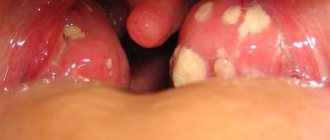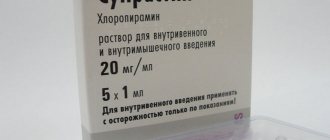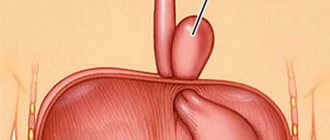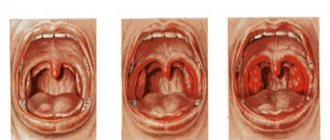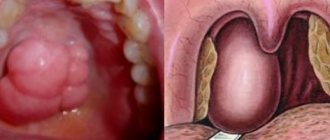Chicken pox
Chickenpox is a viral infection that develops as a result of infection with herpes. The disease is transmitted by airborne droplets or through touch. This is one of the few viruses with 100% susceptibility. If a person does not have immunity to chickenpox, he will definitely become infected upon contact with a sick person.
Chickenpox is considered a childhood disease. As a rule, it occurs in preschool or primary school age. Less than 10% of people contract the virus after age 14. It must be remembered that the older the patient, the more severe the illness. In 97% of cases, people who have had chickenpox will receive lifelong immunity. Only 3% of patients become infected again.
A typical manifestation of the virus is the appearance of a skin rash and fever. If red spots appear on the mucous membranes of the oral cavity, this indicates a severe course of the disease.
Symptoms in adults and children
The older the patient, the more complex the disease. In a child of preschool age, the virus can occur without symptoms or in a mild form, but in adults with chickenpox in the mouth, not only does the throat hurt, but also a burning sensation and itching appears. The disease itself lasts much longer than in children.
A sore throat with chickenpox does not appear immediately. Initially, weakness and deterioration in general health are observed. Next comes a headache and a coating on the tongue. Symptoms do not appear immediately because with chickenpox, the virus spreads throughout the body gradually.
Before the body temperature rises, a sick person experiences a feverish state. The patient feels hot and cold, and the body begins to tremble. The throat begins to hurt after the rash appears. At first, only red dots are visible in the throat, on the palate and the inner surface of the cheeks, but after a few hours they turn into blisters. Once the blisters burst, poorly healing ulcers form. It is during this period that the throat with chickenpox hurts the most. It is painful for the patient to swallow and even speak. It is worth noting that there is almost never a rash on the tongue, but ulcers can occur on the lips.
With chickenpox in children, it is important to prevent the development of concomitant infections. Otherwise, damage to the tonsils and esophagus may occur. If the rash affects the tonsils, the patient develops swelling, the voice changes, a cough occurs, and the pain becomes even stronger.
Complications
If chickenpox is diagnosed in adults, complications occur in a third of cases. This usually requires treatment with antibacterial drugs. Thus, the following complications occur after chickenpox in adult men and women:
- Staphylococci and streptococci can cause bacterial superinfection of the skin. This complication occurs most often and leads to the formation of abscesses, boils and phlegmons at the site of the vesicles. Surgical treatment is often indicated for patients.
- A third of complications occur due to chickenpox pneumonia with the formation of foci of bacterial infiltrates. In this case, the patient experiences a severe cough, shortness of breath and chest pain.
- The most dangerous consequences of chickenpox in adults are associated with damage to internal organs. In this case, the mortality rate reaches 15 percent. The virus can damage the pancreas, spleen, heart, lungs, and liver. Usually there is damage to several internal organs at once. A sharp deterioration in health occurs on the third to fifth day, severe abdominal pain appears.
- Damage to the central nervous system is observed three weeks from the onset of the disease. In this case, the cerebellum is affected, which is expressed in limb tremors, imbalance, and nystagmus. There may also be diffuse encephalitis, manifested by headaches, mental disorders, confusion, vomiting, nausea and epileptic seizures. The severe neurological consequences of encephalitis can persist for a long time.
- Liver damage is less common. Hepatitis often develops against the background of reduced immunity and often ends in death.
READ ALSO: Lipoma (fat): causes, removal, treatment – NaPopravku
Gargling solutions
Hospitalization and treatment under the supervision of a doctor is required only in a particularly severe form of the disease, when the throat is not only red and sore, but also swells so much that the patient’s life is threatened, or urgent care is required at a high temperature that does not go down and gradually rises.
In most cases, treatment takes place at home. Chickenpox is a virus, so the main goal of the patient is to relieve symptoms and help the body cope with the infection. Taking antibiotics in this case is not advisable.
The patient requires plenty of fluids and light fortified foods. Procedures are prescribed to help speed up the healing of ulcers on the mucous membrane. If a sore throat occurs with chickenpox, patients are prescribed a gargle to relieve inflammation and an ointment with an analgesic effect.
What to gargle with? Furacilin is most often used. 1 tablet is diluted in 0.5 glasses of water. The procedure is repeated up to 5 times a day. A solution with calendula tincture is highly effective: 2 tablespoons are required for 1 glass of warm water. pharmaceutical infusion.
From traditional medicine recipes, it is best to prepare an infusion from a mixture of plants such as eucalyptus, calendula, chamomile and flax seeds. You will need 1 tsp. each plant and 250 ml of boiling water. The mixture is poured with hot water and infused for 40-45 minutes. Next, the solution is filtered and used for its intended purpose. For each procedure you will need to prepare fresh product.
When a child is sick, gargling should be done with a eucalyptus solution. The product will not only reduce inflammation, but also reduce pain. You can use weak brewed green tea - this is an absolutely safe remedy that has many healing properties. Green tea reduces discomfort from sore throat.
Adults can use apple cider vinegar, but only as directed by their doctor. A vinegar solution is a good pain reliever.
In order for rinsing to be as effective as possible, you need to follow certain rules. It is worth remembering that the solution should not be swallowed. The procedure is carried out after eating. The product should be warm +20…+25°C.
Chickenpox in a child's throat
Chickenpox - what's going on?
The first symptoms of chickenpox are high fever, a feeling of soreness, loss of appetite, headache, cough and sore throat, usually appear 14 to 16 days after contact with a person infected with this virus. However, symptoms may appear after 21 days.
Some children develop a chickenpox rash without additional symptoms.
Children 6 months and younger may have protection against chickenpox with antibodies passed on to them by their mother. If they become infected with the virus, they may not have symptoms.
People with compromised immune systems may develop the first symptoms of chickenpox sooner than 10 to 14 days after contracting the virus.
The chickenpox rash usually appears on the upper body about 1 or 2 days after symptoms first appear. Usually the most pimples are on the body, and the arms and legs have the least number of pimples. The rash may also spread to the scalp, face, nose, and mouth. In rare cases, it spreads to the upper eyelids (conjunctiva), appears in the clear lining of the eye (cornea), inside the throat, or in the genital area.
After the appearance of red spots with chickenpox, as a rule, in 1 - 2 days they go through all stages of the disease. First, bubbles form, then they burst, dry out and become crusty. New red pimples will appear every day for 5 to 7 days.
Skin infections are the most common complication in children under 5 years of age. Skin infections can develop after scratching rash pimples, which causes bacteria from the surface of the skin or under the nails to become trapped in the blisters. This problem can be serious if left untreated. An infected blister may also leave a scar.
Some people may have more blisters and more severe symptoms than healthy children. Severe disease or complications are more likely to occur in:
Children after mother's infection. Babies born within a few days of their mothers getting chickenpox are at risk of severe illness. Babies born to women who have chickenpox in the first or early second trimester of pregnancy may develop congenital chickenpox syndrome, which can cause birth defects such as eye problems or underdeveloped limbs.
Trimesters of pregnancy
A normal pregnancy lasts about 40 weeks from conception until the baby is born. This time is roughly divided into 3 periods: the first trimester, from conception to 12 weeks of pregnancy, the second trimester, from approximately 13 to 27 weeks of pregnancy, the third trimester, from approximately 28 weeks of pregnancy to the birth of the child.
Each trimester of pregnancy is characterized by its own changes in fetal development.
By the end of the first trimester (about 12 weeks of pregnancy), the fetus takes on a recognizable human shape.
What happens to the throat with chickenpox?
Chickenpox, or otherwise chickenpox, is an acute viral disease characterized by 100% susceptibility. This means that if a person has had contact with someone who has chickenpox, they will definitely become infected and experience the infection. Chickenpox is considered a childhood infection, but it also occurs in adults. Children aged 6 months to seven years are most often affected. Until the age of 10-14, almost everyone gets sick, but there is still a small percentage of those who have not been sick.
Cause of the disease
Chickenpox is caused by a type of herpes virus. Entering the body by airborne droplets, and less often by contact, it penetrates the blood and then settles in the skin cells.
This causes a specific clinical picture characteristic of chickenpox - symptoms of general intoxication and a rash on the skin and mucous membranes. The virus is not persistent in the external environment, but during its life it is easily transferred with air flow, contributing to human infection.
You can only get infected from a sick person. Carriage is safe for others. Having had chickenpox once, a person receives lifelong immunity. But in 3% of cases, re-infection is possible with subsequent development of chickenpox symptoms. The risk group for re-infection includes people with severely reduced immunity.
Symptoms of infection
Initially, the virus settles in the throat on the mucous membrane, and here it begins its primary reproduction. Then, through the flow of lymph and blood, the virus enters the skin cells and infects its surface layer. From the time the virus enters the body until the first symptoms of the disease appear, it takes 11 to 21 days.
Chickenpox begins with a deterioration in general health. Patients complain of:
- headache,
- weakness,
- chills,
- muscle pain,
- temperature rise to 38.5 degrees.
Older people may experience lumbosacral pain. The first elements of a skin rash may appear simultaneously with a rise in temperature, but they are usually detected within 24 hours after a deterioration in health.
In children, symptoms of general intoxication may be mild or completely absent.
The rash first appears as a reddish spot. Over several hours, this spot progresses into a papule with a diameter of up to 5 mm, and then into a vesicle or vesicle. The bubble is surrounded by a red ring, its contents are always transparent. The elements of the rash do not merge with each other. Within a few days, a crust appears at the site of the dried blister, which falls off without leaving scarring on the skin.
New elements of the rash appear within a few days. With chickenpox, a characteristic symptom will be the polymorphism of the rash, because at the same time on the skin you can see the rash at all its stages - from a spot to a crust. The first elements of the rash are usually found on the head or neck. The rash may cover the entire body, but the palms and soles remain untouched by the chickenpox virus.
Fever and headache usually disappear 1-2 days after the rash appears, but in adults, pronounced symptoms of intoxication can continue with chickenpox for up to 7-9 days. Fever may also be accompanied by the appearance of new rashes. Patients often complain of itching of the skin affected by the rash. Itching intensifies with sweating, as well as if the person is hot. Therefore, if you have chickenpox, it is better to avoid overheating.
The throat is the entry point for infection. At the height of the disease, several blisters may appear on the mucous membranes of the mouth and pharynx, the membrane of which quickly collapses. In this case, the person will feel a sore throat. At the site of the vesicle, an ulcer forms, which quickly epithelializes.
A rash in the larynx can lead to swelling, a rough cough, pain when speaking, hoarseness, and, less commonly, croup.
How to treat chickenpox?
There is no need to treat chickenpox with any specific drugs. The body independently develops immunity in 3-5 days and copes with the infection. The prescription of antiviral drugs, in particular acyclovir, is indicated for the first time in the days of illness for elderly people, patients with immunodepression, and people with skin diseases.
The patient most often needs to be treated symptomatically. For severe itching, antihistamines are indicated. A cool shower or bath may relieve the itching somewhat. If you are worried about headache, high temperature, muscle pain, take paracetamol, ibuprofen, nimesulide.
If you have chickenpox, your nails, skin and underwear should always be clean. If you do not follow this rule, then when scratching the rash you may become infected with a secondary bacterial infection. In this case, the complication will have to be treated with antibiotics and antiseptics. If your throat hurts from a rash on the mucous membranes, you can gargle it to eliminate the manifestation of the inflammatory reaction.
The optimal gargle for chickenpox is a weak solution of potassium permanganate; a sore throat can also be reduced by gargling with chamomile and sage decoctions.
Traditional healers suggest treating pain in the mouth and throat with a solution of propolis and apple cider vinegar. The most effective way to prevent chickenpox today is vaccination, which in some developed countries is even included in the compulsory vaccination schedule. Persons who have not had chickenpox under 12 years of age, women of productive age, and elderly people are subject to vaccination.
Chickenpox in the throat
One common disease that causes itching, rashes, and red blisters all over the body is chicken pox, commonly called chickenpox. Children in the first four years of life are most prone to this disease. True, until the age of three months they are protected from infection by the immunity they acquired from their mother. It is worth noting that the older the patient, the more severe the disease.
The cause of chickenpox is a filterable virus belonging to the group of herpes viruses. In environmental conditions, the virus is unstable, but extremely volatile, entering the body through the respiratory tract.
During an illness with chickenpox in the throat, the following periods are distinguished: incubation, prodromal period, periods of rash and crust formation. The first, incubation period lasts from 13 to 17 days in people under 30 years of age, after this age the period lasts from 11 to 21 days. The prodromal period lasts about two days before the onset of the rash. This period in children is easier than in adults and there are much fewer rashes in children.
The chickenpox rash looks like pink spots two to four millimeters in size, which transform into papules and then into vesicles. After one to three days, the vesicles dry out and become covered with a dark red or brown crust. Within three weeks they disappear.
A rash during chickenpox appears not only on the body, but also on the mucous membranes. Chickenpox in the throat is manifested by enanthems, that is, bubbles that, upon bursting, form ulcers with a gray or yellow bottom and a halo of hyperemia around.
Chickenpox is treated in most cases at home. The main thing is to avoid complications, but there is no such specific treatment. Good care, good nutrition, vitamins and hygiene are important aspects of chickenpox treatment.
How to treat rashes on the body and chickenpox in the throat? Ordinary brilliant green (1% alcohol solution of brilliant green) or an intensely colored solution of potassium permanganate will help you in the treatment. If the itching becomes unbearable, you can wipe the itchy areas with a cotton swab dipped in a solution of water and vinegar.
Treat enanthems on the mucous membrane of the larynx by rinsing with a weak pink solution of potassium permanganate. If there is a danger of developing ulcers, the doctor may prescribe antibiotics.
Mironova Larisa, pediatrician www.med-informs.ru
When did the rash appear in your throat and your ear start to hurt? in severe cases, it is advisable to take acyclovir orally, but you are already on the 5th day, and it needs to be started from the first days.
Inspect your mouth carefully for bubbles. manifestations of chickenpox in the mouth are treated like herp stomatitis.
if the rash in the throat (or mouth) is less than 3 days old:
1. Sangviritrin (dilute according to the instructions and with a cotton ball soaked generously in the solution, treat the mouth 5-7 times a day)
2. Acyclovir or Gerpevir ointment (after treatment with an antiseptic)
3. Cholisal or Kamistad (painkillers, anti-inflammatory, antimicrobial) - alternate with acyclovir.
4. Viferon ointment (to enhance local immunity). You can buy dry interferon, dilute it and smear it in your mouth.
5. for severe cases - Acyclovir tablets, 1 tablet. 5 times a day, 5 days.
if the rash in the throat (or mouth) lasts more than 3-5 days:
1.Sangviritrin solution
2. An aqueous solution of methylene blue (blue). Dip a cotton swab and lubricate the sores and gums.
3. Cholisal gel or Kamistad. Lubricate the mucous membrane. They are excellent antiseptics, anti-inflammatory, and pain relievers.
4. Viferon ointment or dry interferon, as described above.
Before meals, you can smear them with them if the child cannot eat normally due to pain.
After 3 days, instead of bluing, you can treat it with sea buckthorn (1 time after sanviritrin - Cholisal, 2 times - sea buckthorn) or vinylin, if you find it in the pharmacy.
How to relieve a sore throat due to chickenpox in a 10 year old child?
How to relieve a sore throat due to chickenpox in a 10 year old child?
Hello. Let's drink something warm and humidify the air. If the temperature is elevated, then the usual antipyretics used in children (paracetamol and
I’m thinking about sending my child (5 years old) to basketball or not. Does playing basketball affect growth? Or is height just a genetic predisposition? Is there medical evidence?
ummmmm. Good evening! I would like to know. what can happen to a child’s immunity if we, parents, refuse vaccinations. Can this affect the deterioration of immunity? (baby 5 months)
Cough with chickenpox in a child
According to statistics, 90 percent of all people on the planet have had chickenpox. Its signs are known to many: fever, rashes on the body, general weakness.
Many mothers notice a cough in their child with chickenpox in the first days of illness. This sign is not considered a classic sign of chickenpox, but the essence of the cough can be boiled down to one thing - thus, the body protects itself from infection.
But the causes of cough with this disease can be completely different.
A cough in a child with chickenpox occurs in the following cases:
- The appearance of rashes in the throat. Rashes that appear in a child on the mucous membranes of the trachea, throat or in the oral cavity can easily provoke a cough. In this case, it is caused by irritation of the mucous membrane and catarrhal phenomena, which consist of a large secretion of mucus, and it must be removed. Once the rash on the mucous membrane of the upper respiratory tract has passed, the cough goes away without any treatment;
- Pneumonia. This is the second reason for coughing during chickenpox. Chicken pox can be complicated by bacterial or viral pneumonia, both of which are accompanied by a cough. With viral pneumonia, the child’s cough will be barking, hysterical and dry, and as a result nothing will be coughed up. And with bacterial pneumonia, it will first be dry, and then a wet cough will develop with purulent profuse sputum. In this case, the cough must be treated, but for this, consult a pediatrician.
Before consulting a doctor, the only thing that can be done is to give a child with chickenpox plenty of fluids, as water will help thin the mucus.
It is advisable to humidify the air in the room where the child is located more often, and all medications are prescribed by the doctor.
Chickenpox. Sore throat. What to do? I'm 20. What should I rinse with? How to get rid of it? 5 days duration already
Academician Artificial Intelligence (253352) 1 year ago
Doctor at home. Chickenpox at your age is a dangerous thing. Isolate yourself from those who have not had chickenpox.
Chris Enlightened (24270) 1 year ago
Principles of chickenpox treatment
If the disease is detected, treatment of chickenpox includes the following basic principles:
1. Limitation of all types of loads. For periods of fever or neurological manifestations - bed rest.
2. Drink plenty of fruit and berry juices.
3. Diet based on dairy products, fruits and vegetables. Restriction of carbohydrates with normal protein content.
4. Strict adherence to the rules of personal hygiene, especially carefully monitor the cleanliness of the external genitalia and the skin of natural folds. Daily showers or quick baths. Do not rub the skin with a towel or washcloth, and do not pick off any crusts that have formed.
5. Use antipyretics to bring down the temperature above 38 degrees. The drug of choice is paracetamol in suppositories, suspensions or tablets. Your doctor may prescribe ibuprofen. Chickenpox requires excluding aspirin from treatment, especially in young children. It can cause very severe liver damage, including death.
6. Antihistamines (suprastin, tavegil, diazolin, fenkarol) as prescribed by a doctor. They speed up the drying of crusts and help relieve itching from chickenpox.
7. External means for treating rash elements (ointment, gel, paste, alcohol and water solutions) are used every day after bathing. They help relieve itching, speed up drying and falling off of crusts, and cure bacterial complications. It is necessary to rinse the mouth and wash the eye slits with antiseptic solutions for enanthems in the throat or conjunctiva.
8. Antiviral drugs (acyclovir, panciclovir, virolex, adenine arabinoside) in the form of ointments, tablets for oral administration or injections. Acyclovir for chickenpox stops the multiplication of the virus and reduces the intensity of the rash. Having an immunostimulating effect, this medicine for chickenpox prevents the generalization of infection and severe complications.
9. Treating chickenpox with antibacterial therapy orally, parenterally or externally in the form of ointments or powders is justified only if bacterial complications are proven.
External remedies for chickenpox
Quick treatment of chickenpox is ensured by regular and frequent use of topical products that have different mechanisms of action. It is only important to know how to use these drugs correctly and in what cases.
1. Chickenpox requires treatment first of all the rashes that appear. To speed up the drying of rash elements and the formation of crusts, alcohol and aqueous solutions of aniline dyes have long been used. The most common is brilliant green. You need to smear each element with a cotton swab. The dye is not washed off until the next treatment, so it allows you to monitor the appearance of new loose elements. The itching after its application also decreases for a short time. But it is better to use a 5% aqueous solution of potassium permanganate, Castellani liquid. They provide quick relief from itching and prevent bacterial infection. Iodine has not been widely used in treatment, as it increases itching. At an older age, fucorcin can be used to remove pustular elements.
2. To get rid of itching, chickenpox is treated with folk remedies. Baths with a decoction of oak bark, joster, chamomile, and sage are useful. If it itches unbearably between baths, you can apply lotions to pimples several times a day, using the same folk remedies for chickenpox, but with a solution of higher concentration.
3. For enanthems in the mouth, on the conjunctiva of the eye, on the genitals, you need to gargle and wash the child with a solution of furacillin, a weak solution of potassium permanganate or boric acid. It is also useful to use the above-mentioned traditional methods of treatment [the link will appear after verification by a moderator]
https://www.med-informs.ru/pediatriya/vetryanka-v-gorle.html
https://conf.7ya.ru/fulltext-thread.aspx?cnf=med&trd=19653
Sources: https://www.eurolab.ua, https://vashegorlo.ru, https://www.med-informs.ru, https://sovet.kidstaff.com.ua, https://doktor. ru, https://vetryanka-stop.ru, https://otvet.mail.ru/question/88221246
Next articles:
- Gargling with hydrogen peroxide for children
- A three month old baby has a red throat
- Red throat for 4 month old baby
September 10, 2020
No comments yet!


